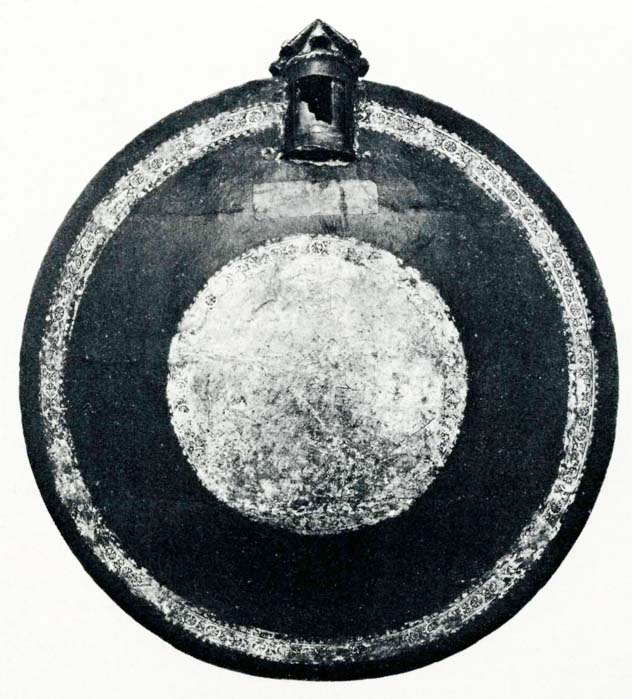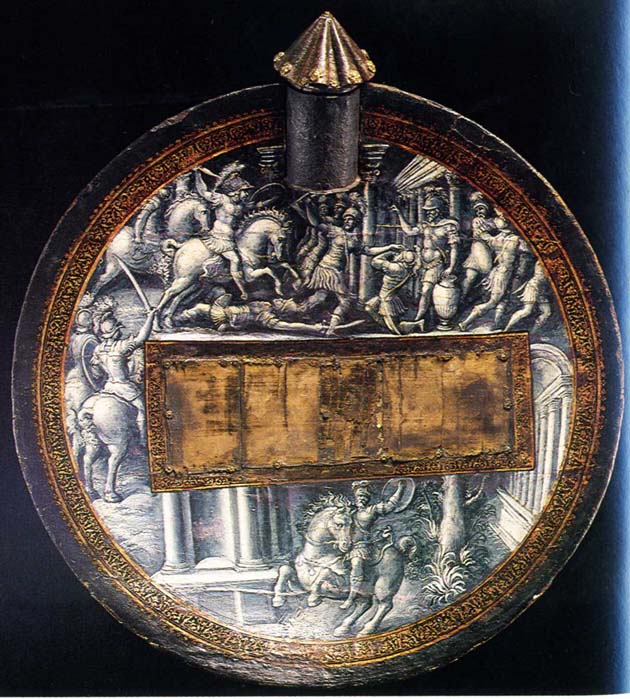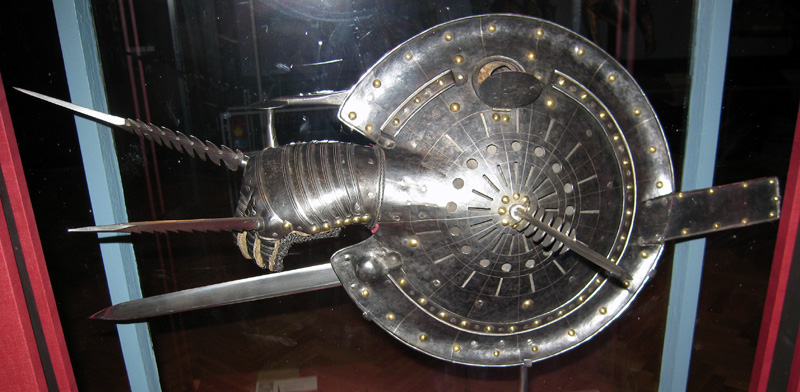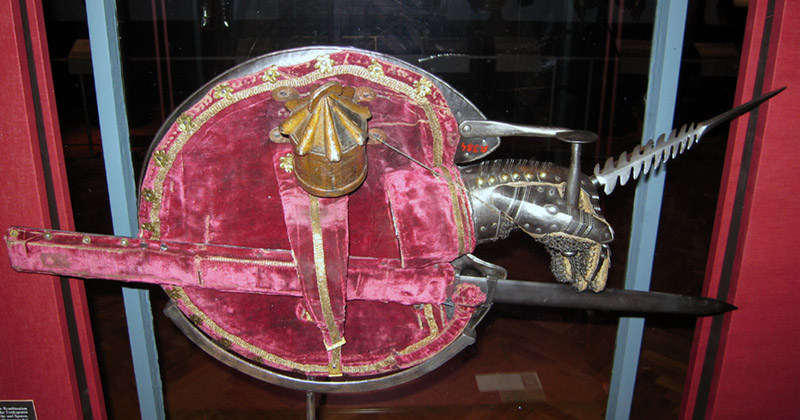So I came across the interesting description of a lantern shield but I cannot find an actual picture or drawing. If anyone has one please share I would very much like to see one. For those who don't know what it is by chance here is the description I came found.
It is a small shield in the shape of a buckler and generally about a foot in diameter. And this basic shield was turned into a veritable swiss army knife of a weapon by the addition of a variety of other things such as a gauntlet with serrated blades. These serrations were theoretically used to break an opponent’s blade. There was also a long blade attached to the shield that ran parallel to the users shield arm. This could be used to thrust at an opponent. The shield also often had spikes protruding from it which could be used as piercing weapons. But the most unusual thing about this weapon, and the thing that gives it its name, is the lantern. It had a hook in the middle of the shield where a lantern could be attached and often times there was a leather flap covering this lantern. The theory was that if attacked the wielder could throw open the flap and the light from the lantern would dazzle and confuse the attacker. It was a bit of psychological warfare thrown in to the mix.
[ Linked Image ]
Spotlight: Combination Weapons
An article by Chad Arnow
Shield with sword blade, gauntlet, sword catchers, and lantern from the Kunsthistorisches Museum, Vienna
This unusual Italian creation seeks to combine many offensive and defensive capabilities into one package. It dates to the first half of the 16th century and combines a shield with multiple blades and an armoured gauntlet.
[ Linked Image ]
Image Copyright myArmoury.com — All rights reserved
Spotlight: Combination Weapons
An article by Chad Arnow
Shield with sword blade, gauntlet, sword catchers, and lantern from the Kunsthistorisches Museum, Vienna
This unusual Italian creation seeks to combine many offensive and defensive capabilities into one package. It dates to the first half of the 16th century and combines a shield with multiple blades and an armoured gauntlet.
[ Linked Image ]
Image Copyright myArmoury.com — All rights reserved
There are a few different types in Stone's Glossary. Some had an integrated gauntlet, some had a central spike, some had spikes around the rim to catch blades. The only thing they have in common is a small circular shape and a hook from which to hang a lantern (hence the name).
Does anyone reproduce these or have a tutorial to make one yourself? These look freaking sweet.
| Jared B wrote: |
| Does anyone reproduce these or have a tutorial to make one yourself? These look freaking sweet. |
Ugo Serrano made one. This is the shield part only I know there was a gauntlet part as well. I bet he would be up for making another but it's not likely to be cheap.
http://www.ugoserrano.com/sheilda44.html
I think his contact info is on this site too.
Some of the descriptions of the lantern shield indicate that it hangs from the shield, some of the pictures look as if there is a cage portion on the actual shield and the lantern sits inside. Does anyone have pics of the shield possessing the lantern? Also does anybody know how effective or widely used these things were. I've never come across this paticular weapon before. I doubt it was strictly military, seems rather specialized. If anyone can add additional information it would be greatly appreciated.
Here's a lantern shield from the Royal Armouries (possibly the Tower). It's Italian, mid 15th century.
 Attachment: 86.15 KB
Attachment: 86.15 KB

Front
 Attachment: 115.96 KB
Attachment: 115.96 KB

Back

Front

Back
Dear Colleagues,
Let me suggest for your attention the pictures of better quality with the lantern shield from Vienna “Rust Kammera”. I don’t like armor and weapon produced after 1540 but that shield really impressed me.
Sincerely,
Oleg
 Attachment: 148.29 KB
Attachment: 148.29 KB

External side
 Attachment: 129.78 KB
Attachment: 129.78 KB

Internal side
Let me suggest for your attention the pictures of better quality with the lantern shield from Vienna “Rust Kammera”. I don’t like armor and weapon produced after 1540 but that shield really impressed me.
Sincerely,
Oleg

External side

Internal side
This thing is really an enigma. What would the context of use of this weapon have been?
What was the sword blade "box" for... retraction presumably, but why would one ever retract it? Certainly not to be less threatening it is still covered in blades. How did the big blade affix in place, was it a manual deal where one would have to lock it in place? Oooh was it spring loaded like a big automatic?!
What does the handle do? Why is the surface of two versions of this full of perforations? Lots of questions.
So does anyone have pics of the one in the Musee d le Armee in France, the one they have there, I recall, was similar in its configuration of pointy bits as the Rustkammer version but different serrated edge bits.
What was the sword blade "box" for... retraction presumably, but why would one ever retract it? Certainly not to be less threatening it is still covered in blades. How did the big blade affix in place, was it a manual deal where one would have to lock it in place? Oooh was it spring loaded like a big automatic?!
What does the handle do? Why is the surface of two versions of this full of perforations? Lots of questions.
So does anyone have pics of the one in the Musee d le Armee in France, the one they have there, I recall, was similar in its configuration of pointy bits as the Rustkammer version but different serrated edge bits.
Read the entire article about combination weapons that I linked to above to get a sense of why many combination weapons were created.
I read it and I thought Mr. Arnow's article was a very good over view on combination weapons, I certainly think his premise that the combination weapons purpose is to surprise and confound is correct, and fits the lantern shield nicely.
But even in the category of odd weapons I think the lantern shield sticks out as a curiosity. For example I see the axe/wheel lock combination and I understand the time frame and context of the wheel lock and I understand the utility of the axe. Its peanut butter and jelly, distinct but recognizable together and apart.
But with the lantern shield, I have never seen (in any other context) a retractable sword mounted to the underside of the forearm in the position this occupies on the shield. I have never seen any other sword breakers as protrusions on shield or on a gauntlet. I also have not seen a shield with perforations like many of these have. I understand the shield part and the lanterns surprising brilliance and usefulness in a dark places. But when all these are put together, it begs (to me at least) further questions.
I know that a contemporary account of its use is unlikely to exist. So I wonder what was happening in the backgound when a Venetian fighter making a decision what weapon to use ends up looking at this and says "ahh yes the lantern shield is the perfect fit."
Here is the musee d le armee version cleaned up due to horrible glare. I knew I had it somewhere:
[ Linked Image ]
But even in the category of odd weapons I think the lantern shield sticks out as a curiosity. For example I see the axe/wheel lock combination and I understand the time frame and context of the wheel lock and I understand the utility of the axe. Its peanut butter and jelly, distinct but recognizable together and apart.
But with the lantern shield, I have never seen (in any other context) a retractable sword mounted to the underside of the forearm in the position this occupies on the shield. I have never seen any other sword breakers as protrusions on shield or on a gauntlet. I also have not seen a shield with perforations like many of these have. I understand the shield part and the lanterns surprising brilliance and usefulness in a dark places. But when all these are put together, it begs (to me at least) further questions.
I know that a contemporary account of its use is unlikely to exist. So I wonder what was happening in the backgound when a Venetian fighter making a decision what weapon to use ends up looking at this and says "ahh yes the lantern shield is the perfect fit."
Here is the musee d le armee version cleaned up due to horrible glare. I knew I had it somewhere:
[ Linked Image ]
There is a contemporary account of the use of lantern shields--an excerpt of which is available from the ARMA website:
http://www.thearma.org/essays/digby.html
The lantern shields/bucklers in that account don't seem to be the OMGWTF combination shield being discussed in the original question and the following pictures, but at least they had lanterns....
http://www.thearma.org/essays/digby.html
The lantern shields/bucklers in that account don't seem to be the OMGWTF combination shield being discussed in the original question and the following pictures, but at least they had lanterns....
| Lafayette C Curtis wrote: |
| There is a contemporary account of the use of lantern shields--an excerpt of which is available from the ARMA website: |
That is a great passage!
Thanks.
The article presented by Lafayette C Curtis was simply awsome. It answers many of our questions regarding the lantern shield and proves to be extremely entertaining in the process. The combat prowess of Sir Digby was astounding.
But back to the point it appears to me that the lantern shield was a weapon of murder and ambush. Obviously not somthing you would take to a duel where the cocept was you and your opponent were on equal footing and skill won the day.
Instead, you go out intending on attacking your opponent under cover of darkness. You possess your sword of choice along with a durable buckler possessing an intergrated gauntlet and several bladed protrusions including a directed beam of light that you can cover and expose at will.
Blinding an opponent with your shield and possesing the abiltiy to perform a shield bash that could leave your opponet with a puctured jugular could make short work of anyone. However as Sir Digby demonstrates in the article found by Lafayette C. Curtis it takes proper skill with any weapon to be effective.
But back to the point it appears to me that the lantern shield was a weapon of murder and ambush. Obviously not somthing you would take to a duel where the cocept was you and your opponent were on equal footing and skill won the day.
Instead, you go out intending on attacking your opponent under cover of darkness. You possess your sword of choice along with a durable buckler possessing an intergrated gauntlet and several bladed protrusions including a directed beam of light that you can cover and expose at will.
Blinding an opponent with your shield and possesing the abiltiy to perform a shield bash that could leave your opponet with a puctured jugular could make short work of anyone. However as Sir Digby demonstrates in the article found by Lafayette C. Curtis it takes proper skill with any weapon to be effective.
Obviously we don't know if the combattants in the Digby story had a simple buckler with a lantern like I posted or the elaborate setup with a gauntlet, sword, blade, spikes, etc.
I'm inclined to believe the elaborate one(s) was likely made as a curiosity. If you are going to veil and unveil the light to confuse your opponent or extend and retract the blade, you're going to be using your right hand to do so (as your left is strapped into the contraption) and you're going to leave yourself open for attack while you're busy monkeying around with the contraption. :) If you are going to use a weapon with your right hand, it will be even more difficult to operate the shield, since your sword-hand would be used to mess with the lantern and extendable blade.
For the record, I didn't state that the point of combination weapons was "to surprise and confound". The point of some weapons might have been, though for a number of those weapons, the surprise element comprises the overall functionality of the weapon. I still see many of them as wealthy people's curiosities.
I'm inclined to believe the elaborate one(s) was likely made as a curiosity. If you are going to veil and unveil the light to confuse your opponent or extend and retract the blade, you're going to be using your right hand to do so (as your left is strapped into the contraption) and you're going to leave yourself open for attack while you're busy monkeying around with the contraption. :) If you are going to use a weapon with your right hand, it will be even more difficult to operate the shield, since your sword-hand would be used to mess with the lantern and extendable blade.
For the record, I didn't state that the point of combination weapons was "to surprise and confound". The point of some weapons might have been, though for a number of those weapons, the surprise element comprises the overall functionality of the weapon. I still see many of them as wealthy people's curiosities.
I agree with you to a certain extent Mr.Arnow
It is quite likely that the more elaborate lantern shields with their various weapons complement could be more for show and prestige than fuctionality. This could be validated by the fact that lantern shields are not exactly well known. Beyond the circles of historical arms they are virtually unheard of.
But in my expierence any weapon no matter how showy comes from some applicable form. As for the practacality of using a fully complemented lantern shield in battle. I would expect they would have the retractible blade and lantern cover in their desired states prior to the battle. This item does not strike me as a weapon on the fly, but a weapon designed and meant to be used for a specific purpose at a specific time.
In my oppinon the lantern shield is not a weapon of a warrior fighting four honor, country, or glory. It's a killer's weapon meant to be used to blind, confuse and surpise an opponet in the dark with the intent of simply killing them. I mean some of the designs look like they were made to be as lethal as possible. However at the same time they could be interpreted as overkill and impratical.
I like the idea of the lantern shield and would like to belive that they were just as effective as they were sinister in appearence.
It is quite likely that the more elaborate lantern shields with their various weapons complement could be more for show and prestige than fuctionality. This could be validated by the fact that lantern shields are not exactly well known. Beyond the circles of historical arms they are virtually unheard of.
But in my expierence any weapon no matter how showy comes from some applicable form. As for the practacality of using a fully complemented lantern shield in battle. I would expect they would have the retractible blade and lantern cover in their desired states prior to the battle. This item does not strike me as a weapon on the fly, but a weapon designed and meant to be used for a specific purpose at a specific time.
In my oppinon the lantern shield is not a weapon of a warrior fighting four honor, country, or glory. It's a killer's weapon meant to be used to blind, confuse and surpise an opponet in the dark with the intent of simply killing them. I mean some of the designs look like they were made to be as lethal as possible. However at the same time they could be interpreted as overkill and impratical.
I like the idea of the lantern shield and would like to belive that they were just as effective as they were sinister in appearence.
There are actually a number of the bucklers with just the lantern (like the one I posted) that have survived. But how many of the fancy/ridiculous ones do we know of? To play devil's advocate, if they were so effective, why don't we see more of them? :) And if the lantern cover is in place prior to the battle, the user loses the element of surprise, right?
These combination weapons do have elements of real battlefield weapons and some may have been such, but some are more ridiculous and less practical.
The "super-shield" strikes me as impractical in a number of ways. With the blade extended, it seems like that blade might get in the way of your right hand. Therefore, the defensive capability of the shield might be limited since you can't move it anywhere you like (because you have to account for its blade). On top of that, with your arm/hand inserted into the gauntlet, the shield would ride farther back/up the left forearm than similar shields. The gauntlet and its spikes will kind of make up for that, I guess. Looking at it again, the lantern would sit nearer to by elbow than I would prefer. If your arm is bent and you're holding the shield close to you for defense, the hot lantern would be very close to your bicep. If you aren't holding it close (or can't), you lose some of its defensive value and that's also a lot of weight to have hanging on your arm. And why have the articulated gauntlet if you have to hold onto that built-in handle for stability/control? :)
I guess it strikes me as not terribly practical. Our ancestors had to rely on their weapons and armour, so practicality would rule the day when talking about real weapons (not showpieces and curiosities).
But these statements are just my opinion. I admire the craftsmanship of the shield, but have doubts about its practicality.
These combination weapons do have elements of real battlefield weapons and some may have been such, but some are more ridiculous and less practical.
The "super-shield" strikes me as impractical in a number of ways. With the blade extended, it seems like that blade might get in the way of your right hand. Therefore, the defensive capability of the shield might be limited since you can't move it anywhere you like (because you have to account for its blade). On top of that, with your arm/hand inserted into the gauntlet, the shield would ride farther back/up the left forearm than similar shields. The gauntlet and its spikes will kind of make up for that, I guess. Looking at it again, the lantern would sit nearer to by elbow than I would prefer. If your arm is bent and you're holding the shield close to you for defense, the hot lantern would be very close to your bicep. If you aren't holding it close (or can't), you lose some of its defensive value and that's also a lot of weight to have hanging on your arm. And why have the articulated gauntlet if you have to hold onto that built-in handle for stability/control? :)
I guess it strikes me as not terribly practical. Our ancestors had to rely on their weapons and armour, so practicality would rule the day when talking about real weapons (not showpieces and curiosities).
But these statements are just my opinion. I admire the craftsmanship of the shield, but have doubts about its practicality.
I think the Vienna “Rust Kammera” lantern shield meets all of Mr. Arnow's points of impractacality. I can't imagine using a weapon such as that gracefully. One would think the sword catchers alone could cause movement issues. Also what if the "Super-shield" as we are calling it was meant to be a primary weapon and not a support weapon. Especially one possesing the fore-blade.
I can't deny or debate Mr. Arnow's views mostly because I agree with them. But what would cause somebody to add these extra offenseive bits to say a simple lantern shield? somwhere at sometime somebody had a reason to do so and it proved effective enough to repeat.
My speculations have been aimed at the possible reasons and the scenario that would enable a weapon such as the lantern shield to exist and prove effective. Or the lantern shield could be much like the Flying guillotine, great in theory but falls short in practice. :D
I can't deny or debate Mr. Arnow's views mostly because I agree with them. But what would cause somebody to add these extra offenseive bits to say a simple lantern shield? somwhere at sometime somebody had a reason to do so and it proved effective enough to repeat.
My speculations have been aimed at the possible reasons and the scenario that would enable a weapon such as the lantern shield to exist and prove effective. Or the lantern shield could be much like the Flying guillotine, great in theory but falls short in practice. :D
| Chad Arnow wrote: |
| For the record, I didn't state that the point of combination weapons was "to surprise and confound". The point of some weapons might have been, though for a number of those weapons, the surprise element comprises the overall functionality of the weapon. I still see many of them as wealthy people's curiosities. |
Poorly worded on my part. :) ...sorry
It also seems from that account that they were something for the less skillful if not rabble. The Vienna "super shield" seems too well appointed to be a tool of thugs though. Possibly it was for body guards to the wealthy? Someone who needed high drama in order to make a statement about who they were or were with.
As ungainly as it may have been these all seem to have a dangerous (or opulent) presence.
Page 1 of 4
You cannot post new topics in this forumYou cannot reply to topics in this forum
You cannot edit your posts in this forum
You cannot delete your posts in this forum
You cannot vote in polls in this forum
You cannot attach files in this forum
You can download files in this forum
All contents © Copyright 2003-2006 myArmoury.com — All rights reserved
Discussion forums powered by phpBB © The phpBB Group
Switch to the Full-featured Version of the forum
Discussion forums powered by phpBB © The phpBB Group
Switch to the Full-featured Version of the forum